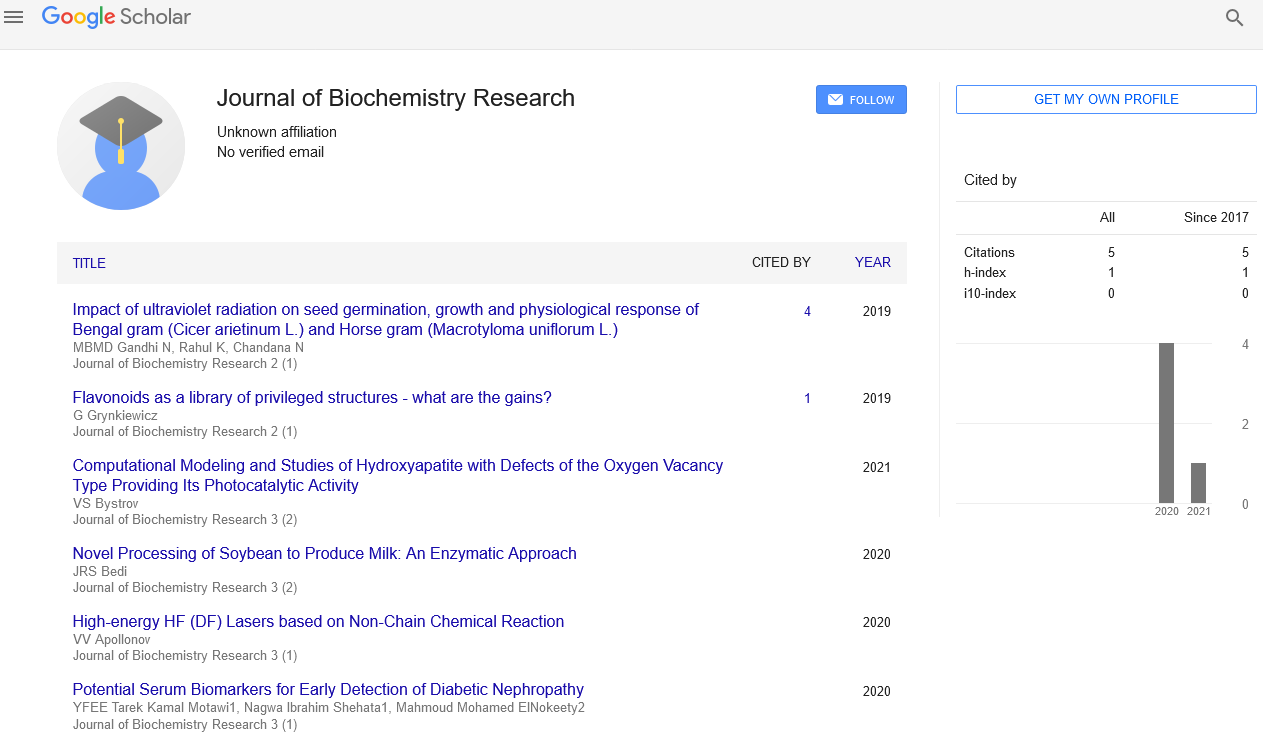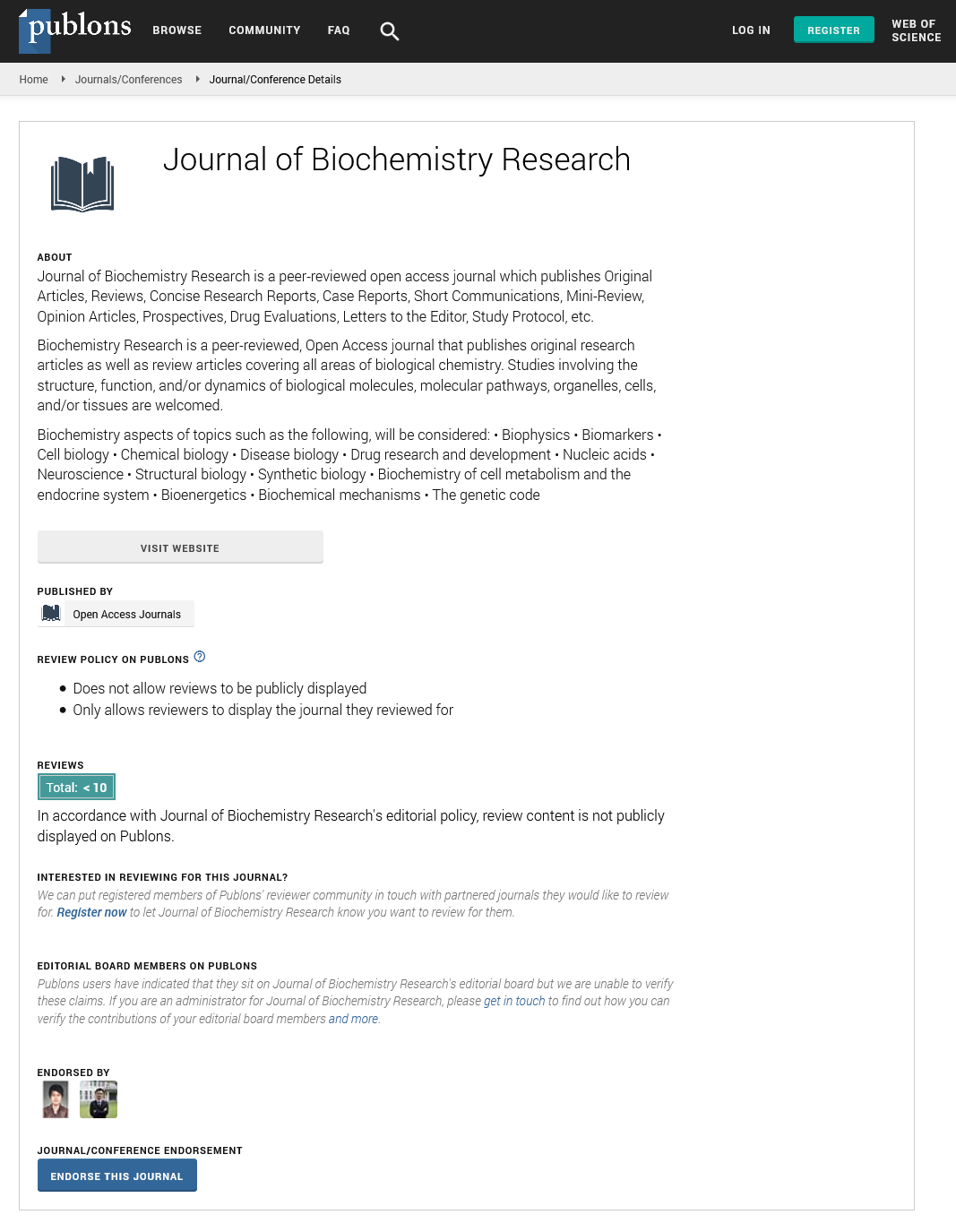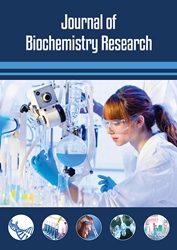Mini Review - Journal of Biochemistry Research (2023) Volume 6, Issue 2
Biologically active molecules: Nucleic acids including DNA and RNA
Dr. Ranjna Sajid*
Department of gene regulation biochemistry and Gene Transformation, University of Stanford, United States
Department of gene regulation biochemistry and Gene Transformation, University of Stanford, United States
E-mail: rooneytom@gmail.com
Received: 03-April-2023, Manuscript No. oabr-23-96866; Editor assigned: 05-April-2023, PreQC No. oabr-23-96866; Reviewed: 19-April-2023, QC No. oabr-23-96866; Revised: 21-April-2023, Manuscript No. oabr-23-96866 (R); Published: 28-April-2023; DOI: 10.37532/ oabr.2023.6(2).44-46
Abstract
Biochemistry is the study of chemical processes within living organisms. These processes are driven by a vast array of molecules that play crucial roles in maintaining the structural and functional integrity of cells and tissues. Among these molecules are biologically active compounds, which are organic molecules that have important physiological effects on the body. Biologically active molecules include a broad range of compounds, such as proteins, enzymes, nucleic acids, lipi ds, carbohydrates, and vitamins, among others. Proteins are the most abundant biologically active molecules in cells, and they perform a wide range of functions, including catalyzing chemical reactions, transporting molecules across membranes, and providing structural support. Enzymes are a type of protein that acts as catalysts, speeding up chemical reactions in cells. They are e
Keywords
Biochemistry • Living organism’s • Cells and tissues • Biologically active compounds • Biologically active molecules • Proteins • Enzymes • Nucleic acids • lipids • Carbohydrates • Vitamins • Respiration
Introduction
Biochemistry is the branch of science that studies the chemical processes and molecules involved in living organisms. One of the most important groups of molecules studied in biochemistry is biologically active molecules. These are molecules that are involved in various processes in living organisms, such as metabolism, growth, and communication between cells [1]. Biologically active molecules can be small molecules like hormones, neurotransmitters, and enzymes, or large molecules like proteins and nucleic acids. Understanding the structure, function, and regulation of biologically active molecules is crucial for understanding the mechanisms of various biological processes and diseases, and for developing new drugs and therapies. In this context, biochemistry plays a vital role in advancing our knowledge of the molecular basis of life [2].
Biochemistry is the study of chemical processes that occur within living organisms. It is an interdisciplinary field that combines elements of chemistry, biology, and physics to understand the chemical reactions that take place in living systems. One of the fundamental aspects of biochemistry is the study of biologically active molecules. Biologically active molecules are molecules that are involved in biological processes in living organisms. These molecules can be organic or inorganic and can be found in all living organisms, from bacteria to plants and animals [3]. Biologically active molecules are essential for life, as they play a critical role in many biological processes such as metabolism, DNA replication, protein synthesis, and cellular signalling.
There are several types of biologically active molecules that are important in biochemistry, including enzymes, hormones, neurotransmitters, and nucleic acids.
Nucleic acids including DNA and RNA
These are another class of biologically active molecules that play a critical role in the functioning of cells. DNA carries the genetic inform ation that determines the characteristics of an organism, while RNA plays a role in gene expression, translation, and regulation [4]. Lipids are a diverse group of biologically active molecules that include fatty acids, phospholipids, and cholesterol. They are essential components of cell membranes and play a crucial role in cell signaling, energy storage, and hormone synthesis. Carbohydrates are another important class of biologically active molecules that include sugars, starches, and glycogen [5]. They provide energy for the body and serve as structural components of cell walls and extracellular matrices. Vitamins are biologically active molecules that are essential for maintaining health and preventing disease [6]. They include a broad range of compounds, such as vitamins A, B, C, D, and E, and play important roles in processes such as immune function, metabolism, and bone health. Biologically active molecules are also found in many natural products, such as plant extracts and herbal remedies [7]. These compounds have been used for centuries in traditional medicine and have been the subject of extensive research in modern times. Many of these natural products have been found to have potent pharmacological effects and have been developed into drugs for the treatment of various diseases.
Enzymes are proteins that catalyze chemical reactions in living organisms. Enzymes are essential for metabolism, as they help to break down complex molecules into simpler ones that can be used by cells. Enzymes are also involved in DNA replication, protein synthesis, and cellular signalling. Enzymes are highly specific and can catalyze only one type of chemical reaction [8].
Hormones are chemical messengers that are produced by endocrine glands in the body. Hormones are involved in many physiological processes, including growth and development, metabolism, and reproductive functions. Hormones act by binding to specific receptors on target cells, triggering a cascade of chemical reactions that ultimately result in a physiological response. Neurotransmitters are chemical messengers that are involved in communication between neurons in the brain and nervous system. Neurotransmitters are involved in a wide range of physiological processes, including memory, mood, and sleep [9]. Neurotransmitters act by binding to specific receptors on neurons, triggering a cascade of chemical reactions that ultimately result in the transmission of signals between neurons. Nucleic acids are the building blocks of DNA and RNA, which are essential for genetic information storage and protein synthesis. Nucleic acids are made up of nucleotides, which are composed of a sugar molecule, a phosphate group, and a nitrogenous base. DNA contains four types of nitrogenous bases: adenine, guanine, cytosine, and thymine, while RNA contains uracil instead of thymine.
Biologically active molecules are highly complex and interact with each other in complex ways to regulate physiological processes in living organisms. Understanding the structure and function of these molecules is essential for developing new treatments for diseases and improving our understanding of the biology of life. In recent years, there has been a growing interest in the use of biologically active molecules for therapeutic purposes. Many drugs currently used in medicine are biologically active molecules that are designed to target specific physiological processes in the body [10]. For example, insulin is a hormone that is used to treat diabetes, while statins are drugs that are used to lower cholesterol levels in the blood.
Conclusion
Biologically active molecules are essential for life and play a critical role in many physiological processes in living organisms. The study of these molecules is essential for understanding the biology of life and developing new treatments for diseases. As our understanding of these molecules continues to grow, we can expect to see new and innovative approaches to treating diseases and improving the quality of life for people around the world. Biologically active molecules are a diverse group of compounds that play critical roles in the functioning of living organisms. They are essential for maintaining the structural and functional integrity of cells and tissues and are involved in a wide range of physiological processes. Understanding the chemistry and biology of these molecules is critical for advancing our knowledge of biochemistry and developing new therapies for the treatment of disease.
Biologically active molecules are essential to the study of biochemistry as they play vital roles in many biological processes. These molecules include enzymes, hormones, neurotransmitters, and DNA. They act as messengers, regulators, and catalysts, enabling the body to carry out complex biochemical reactions efficiently. The study of these molecules has led to a better understanding of many diseases and their underlying mechanisms, as well as the development of new therapies and drugs to treat them. Biochemists continue to explore the diverse functions and interactions of biologically active molecules, providing insights into the complexity and wonder of life itself.
References
- Kittakoop P, Mahidol C, Ruchirawat S et al. Alkaloids as important scaffolds in therapeutic drugs for the treatments of cancer, tuberculosis, and smoking cessation. Curr Top Med Chem. 14, 239-52 (2012).
- Russo P, Frustaci A, Del Bufalo A et al. Multitarget drugs of plants origin acting on Alzheimer's disease. Curr Med Chem. 20,1686-93(2013).
- Kumanyika S, Jeffery RW, Morabia A et al. Obesity prevention: the case for action. Int J Obes (Lond). 26, 425-36 (2002).
- Booth FW, Chakravarthy MV. Physical activity and dietary intervention for chronic diseases: a quick fix after all. J Appl Physiol. 100, 1439-40 (2006).
- Beccuti G, Monagheddu C, Evangelista A et al. Timing of food intake: Sounding the alarm about metabolic impairments? A systematic review. Pharmacological Research. 125, 132–141 (2017).
- Anderson JW, Ward K. High-carbohydrate, high-fiber diets for insulin-treated men with diabetes mellitus. Am J Clin Nutr. 32: 2312-21 (1979).
- Booth FW, Chakravarthy MV. Physical activity and dietary intervention for chronic diseases: a quick fix after all. J Appl Physiol. 100, 1439-40 (2006).
- Reynolds A, Mann J, Cummings J et al. Carbohydrate quality and human health: a series of systematic reviews and meta-analyses. Lancet. 393, 434-445 (2019).
- Carrillo JE, Carrillo VA, Perez HR et al. Defining and targeting health care access barriers. J Health Care Poor Underserved. 22, 562-75 (2011).
- Jones G, Steketee RW, Black RE et al. How many child deaths can we prevent this year? Lancet. 362, 65-71 (2003).
Indexed at, Google Scholar, Crossref
Indexed at, Google Scholar, Crossref
Indexed at, Google Scholar, Crossref
Indexed at, Google Scholar, Crossref
Indexed at, Google Scholar, Crossref
Indexed at, Google Scholar, Crossref
Indexed at, Google Scholar, Crossref
Indexed at, Google Scholar, Crossref
Indexed at, Google Scholar, Crossref


